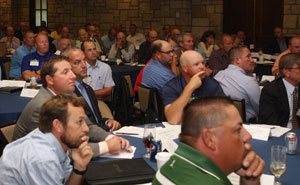— Bob Nielsen, CGCS at Bedford (N.Y.) Golf and Tennis Club
 The annual GCSAA Chapter Delegates Meeting (Oct. 1-2) took on a decidedly different appearance this year, as the focus was not so much on the current state of affairs, but more on the future of the association and the profession.
The annual GCSAA Chapter Delegates Meeting (Oct. 1-2) took on a decidedly different appearance this year, as the focus was not so much on the current state of affairs, but more on the future of the association and the profession.
“We were intent on getting feedback on what the profession would look like in the future, targeting the range of 2020 to 2025,” GCSAA President Patrick R. Finlen, CGCS, said. “It became obvious to the board through our discussions with those in the golf industry, including members, that the profession is experiencing rapid change. Superintendents are being asked to do more, and the tools and resources we use to do that job are changing. Just look at what is happening with technology. The game of golf may not be changing much, but how we manage it is.”
Peering into the crystal ball
To begin the process, attendees were shown a video featuring GCSAA members representing different membership classes, years of service, ownership structure and budget size. They were then asked to offer their thoughts on what the future would entail for members and how GCSAA might be of assistance. The video can be accessed by loading the following link in a web browser:
Extensive time was also spent in breakout sessions, addressing the following questions:
- Would it be advantageous for GCSAA to simplify/narrow membership classes?
- Should GCSAA enhance Class A standards?
- What would motivate a member to achieve Class A status?
- If changes are to be made, how quickly should implementation occur?
“We weren’t looking for the delegates to construct how we get to the future, rather we asked them what the profession would require in terms of competencies,” Finlen said. “With that feedback, we can then set in motion the plans for how GCSAA can best help members achieve future success.”
According to Finlen, the delegates were strongly in support of the need to more narrowly define membership classes and enhance standards. However, opinions varied as to what the standards would look like and the timeline for implementing them. He said the next step would be for the board to engage GCSAA members and others outside the membership in the coming months to get a greater diversity of input.
First-year Peaks and Prairies GCSA delegate Dan Tolson, Class A member at 3 Creek Ranch Golf Club in Jackson Hole (Wyo.), found his experience to be thought-provoking. “I really did not know what to expect, but it was an eye-opener for me just to sit and listen to people talk about the issues and how members are impacted,” he said. “It will be interesting to go back to my chapter and hear what the members have to say. I was impressed by the deep thought the delegates put into the questions.”
State of the association
Finlen and GCSAA Chief Executive Officer Rhett Evans briefed delegates on various programs and services, noting the 2014 GCSAA business plan would continue to focus on the following priorities:
- Enhance technology to allow GCSAA to better serve members and provide them with tools that provide on-course solutions
- Complete the implementation of the field staff program and the extension of member services to regions/chapters
- Dedicate additional resources to advocating on behalf of members to golfers, employers and policymakers
- Enhance education programming and evaluate membership classifications to remain relevant in the marketplace
- Explore means to increase revenues through traditional and non-traditional sources
- Continue to be prudent in exploring and implementing programs and services that expand GCSAA’s contribution to growing the game worldwide
“This was a great meeting,” said Metropolitan GCSA delegate and Class A member Bob Nielsen, CGCS at Bedford (N.Y.) Golf and Tennis Club. “This is my ninth delegates meeting, and I really sensed optimism and a clear vision for the future. The work done in the past is having an impact. Superintendents have respect and are at the table. Now we have to figure out how we build on that momentum for the future.
“I think there was a time GCSAA and the members were on the defensive, just trying to keep what we have. Now I feel we are on the offense. GCSAA and its members are doing good things and we’re being recognized for it.”
Not business as usual
For the first time since 1999, the entire function was conducted in Lawrence, Kan., with the majority of the time spent at the association’s headquarters. It was also held on successive weekdays for the first time instead of following the traditional weekend schedule. While a post-event survey is being conducted, a straw poll indicated the new format was preferred by the majority of those in attendance (83 delegates representing 87 chapters).
Delegates also had the opportunity to hear from those members running for national office and to participate in small breakout sessions to learn more about candidate platforms and philosophies. The slate of candidates includes:
- For president:
Keith A. Ihms, CGCS, Country Club of Little Rock (Ark.) - For vice president:
John J. O’Keefe, CGCS, Preakness Hills Country Club, Wayne, N.J. - For secretary/treasurer:
Peter J. Grass, CGCS, Hilands Golf Club, Billings, Mont.
Bill H. Maynard, CGCS, Country Club of St. Albans (Mo.) - For director:
Rafael Barajas, CGCS, Hacienda Golf Club, LaHabra Heights, Calif.
Mark F. Jordan, CGCS, Westfield Group Country Club, Westfield Center, Ohio
John Walker, Bentwater Country Club, Montgomery, Texas